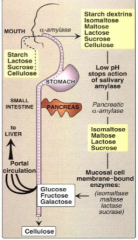![]()
![]()
![]()
Use LEFT and RIGHT arrow keys to navigate between flashcards;
Use UP and DOWN arrow keys to flip the card;
H to show hint;
A reads text to speech;
22 Cards in this Set
- Front
- Back
|
Because of the ____ group on monosaccharides, most sugars can be _____ on the basis of oxidation in an alkaline solution by ___ ___ ___
Because of this, most monosaccharides are ___ sugars since they get ____ in the process of ____ other things What does the group change to? |
aldehyde
quantified Cu2+, Ag+, ferricyanide reducing, oxidized, reducing COOH |
|
|
What makes up maltose?
Is this a reducing sugar? |
Glc α1,4 Glc
Yes |
|
|
What makes up isomaltose?
Is this a reducing sugar? |
Glc α1,6 Glc
Yes |
|
|
What makes up sucrose?
Is this a reducing sugar? |
Glc α1,2 Fru
Nope |
|
|
What makes up lactose?
Is this a reducing sugar? |
Gal β1,4 Glc
Yes |
|
|
How long are oligosaccharides?
|
3-10 sugars
|
|
|
How do you get a glycoprotein?
What types of links are there? |
oligosaccharides + protein
N-linked oligosaccharide (Asn-linked) O-linked oligosaccharide (Ser/Thr-linked) |
|
|
What do proteins in our blood look like?
|
N-glycosylated proteins
|
|
|
What's an oligosaccharide and lipid get you?
|
glycolipid
|
|
|
What are three polysaccharides classes we talked about?
|
Starch
Glycogen Cellulose |
|
|
Starch
Who makes it? What are two types (and their defining characteristics)? |
Plants to store glc
amylose- linear polymer of glucose in α1,4 linkages amylopectin- branched Glc polymer with 1 (α1,6) branch every 25 (α1,4) |
|
|
Glycogen
Who makes it? What does it look like? What is special about its reducing end? |
animals
Branched glc polymer with 1 (α1,6) branch every 12 (α1,4) (twice as frequently as amylopectin) Has a glycogenin cap and nonreducing ends at the ends of branches |
|
|
Cellulose
Who makes it? What does it look like? Interesting facts (2) |
Plants
Polymer of glc in β1,4 linkages Most abundant organic compound in nature (50% of vegetation). Bacteria use cellulase to degrade- make H2, methane, H2S gases in process. |
|
|
Difference between insoluble and soluble fiber.
|
Soluble fiber like pectin is made of galacturonic acid and GalNAc making a viscous gel that sludges through GI tract.
Insoluble fibers like bran and lettuce increase stool bulk and regularity |
|
|
When we eat what kinds of CHO are we taking in?
|
Poly's: starch, cellulose, pectins, glycogen
Di's: sucrose, lactose, maltose (syrup) mono's: very little |
|
|
How does CHO digestion begin?
|
Salivary α amylase
attacks α1,4 Glc links randomly making maltose, dextrins, glc. Ends when bolus enters stomach as HCl denatures α amylase |
|
|
After exiting the stomach, what happens in CHO digestion?
|
pancreatic α amylase
cuts randomly at α1,4 glc links. dextrins -> maltose, isomaltose |
|
|
As CHO's travel down our intestines how are they digested?
Why is this like so super important, and why doesn't a diet company jump on this ****? |
The intestinal brush border has a variety of disaccharidases like
maltase isomaltase sucrase lactase We can't absorb disaccharides so obvi pills to block these enzymes would reduce sugar intake cals. |
|
|
OMG CLINICAL CORRELATE
#LactaseDeficiencyProblems What populations shouldn't eat cheese? #solutions |
lactase high at birth, goes down in adulthood (eu->heterochromatin), some people too much and when they try to eat lactose (read: dairy products) they get diarrhea and bloating. Since they aren't digesting the lactose, the bacteria in their gut go to town making lots of gases and other stuff via anaerobic respiration which changes osmotic pressures, drawing water into the gut which means not very fun times.
Africans, Asians. Europeans have highest lactase levels. Can give enzymes or avoid eating lactose (babies with congenital absence of lactase get sucrose based formula) |
|
|
How our glc absorption system works:
What are relative concentrations of key molecules? So how do we get the glc in then? But where does that energy COME FROM!? |
Active transport
Na is high in lumen and blood, low inside intestinal cells Glc is the opposite, low in blood and lumen, high inside intestinal cells. Symport Glc with Na into the cell. Can just use transporter to move it out since it's downhill gradient. The energy used directly is from the Na gradient, so indirectly from those energy dependent Na pumps working so hard to pump Na into blood. |
|
|
So draw a picture of all the digestion of CHO we learned in this lecture.
|

Make sure only monosaccharides were going in the portal circulation. Also cellulose went straight through.
|
|
|
He went off about ®Equal™. Soooooo is it OK or not according to him?
What undermined his point during the lecture? |
Because aspartame is made up of Asp-Phe with methyl ester C terminus, and these get cleaved to normal things except the methyl -> MeOH -> formaldehyde which are bad but you have to take in copious amounts for this to be dangerous.
He didn't address the idea of continuous, long term, daily exposure to small amounts of the MeOH and formaldehyde. He also said that just because someone says it doesn't make it true, and he was saying all sorts of stuff, but that doesn't make it true. For all we know, he invests in Equal market shares. |

